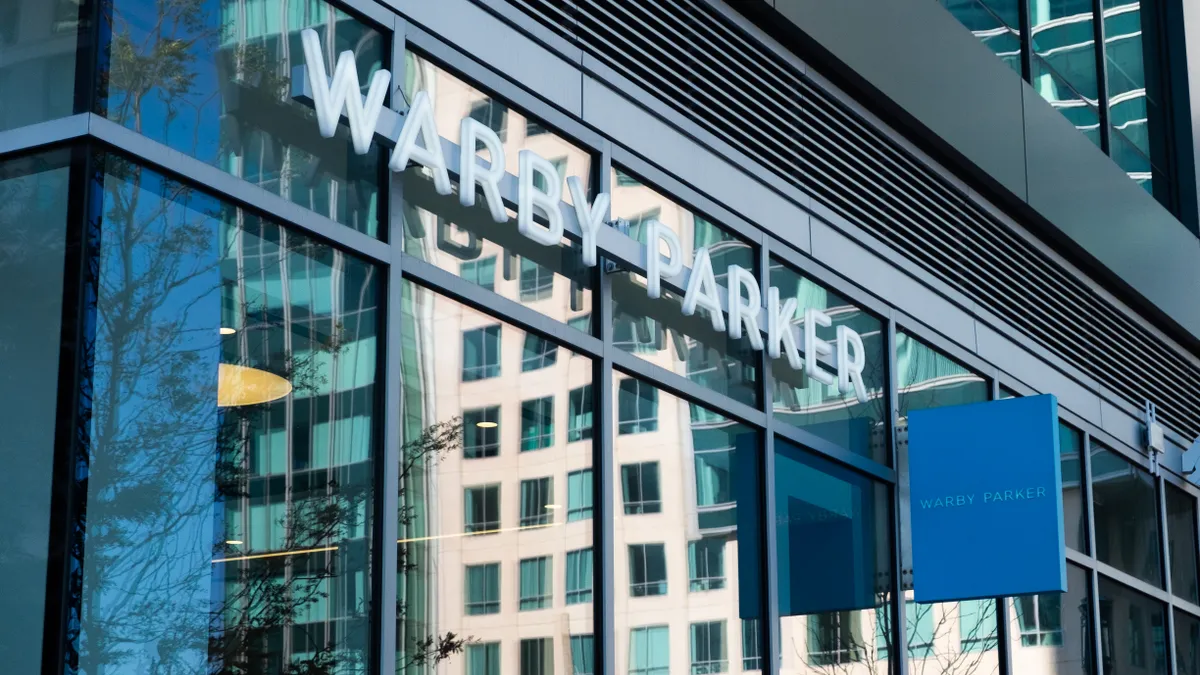Dive Brief:
- In its first earnings report as a publicly traded company, Warby Parker on Friday reported net revenue increased 32% year over year to $137.4 million. Compared to 2019, net revenue increased 45%.
- The DTC eyewear brand added 395,000 active customers in the period, up 23% from the year-ago period, bringing the total to 2.15 million. The company opened nine new stores in the third quarter, pushing year-to-date openings to 28 and total stores to 154, according to a company press release.
- Warby Parker's losses more than doubled in the period. Operating loss grew to $92 million from $41.3 million last year and a profit of $1.5 million in 2019. Net loss was $91.1 million from $41.6 million last year and an income of $1.4 million in 2019.
Dive Insight:
Fresh off its direct listing in late September, Warby Parker exceeded its own net revenue expectations.
Ahead of its public debut, the DTC brand issued guidance projecting third quarter net revenues to reach between $131 million and $133 million, a 26% to 28% increase from last year. Warby Parker on Friday also raised its full-year outlook, now projecting revenues to be between $539.5 million and $542 million, up from the previously predicted $532 million to $537 million.
But even as the brand grew its revenues and customer base, its losses widened.
"Given Warby Parker is in expansion mode and is actively acquiring new customers as well as opening new stores, and pushing into new product lines, some weakness on the bottom line is to be expected. It is the price paid for growth," GlobalData Managing Director Neil Saunders said in emailed comments. "However, at some point the company needs to show it can take these gains and turn them into a profitable line of business."
Profitability is something many direct-to-consumer brands struggle with, as the cost to acquire customers online is oftentimes prohibitively high. To offset those costs, many DTC brands have turned to physical retail, through pop-ups, permanent stores or partnerships with retailers.
"We deliberately designed our stores to serve as billboards and have found them to be highly effective in driving brand awareness, new customer acquisitions, and in serving our existing customer base," co-founder and co-CEO Dave Gilboa said on a call with analysts Friday. "Our stores serve as an integral complement to our website and apps in creating a holistic and seamless omnichannel customer experience. … A customer journey that starts in a store can end with a purchase online and vice versa."
For the remainder of the year, Warby Parker expects to open seven more stores, pushing the total opened this year to 35 — the most stores the retailer has opened in a single year, according to executives.
The brand's core product, glasses, is something purchased relatively infrequently, which means Warby Parker relies heavily on acquiring new customers, Saunders noted. To help drive repeat purchases and increase loyalty among existing customers, the brand has pushed into adjacent categories, notably contact lenses, which make up 5% of the total business. Though contact lenses "have a lower margin profile than our core glasses offering," they have a higher repeat purchase rate, executives said.
"We applaud this move, both because it provides another stream of revenue and because it helps cement the company as a destination for vision care," Saunders said.














